Summer has finally given way to Fall here in Southeast Texas. I must admit that weeks ago I began longing for Tennessee’s crisp autumn days and fall colors, as well as the many Living History and Heritage Day Festivals and cemetery walks scheduled each September and October. These events bring history to life with dozens of historical demonstrations, hands-on activities, and captivating reenactors. While Texas has its share of such events, it’s a big state and there aren’t as many within easy reach as in Tennessee. So, I was thrilled to attend the town of Montgomery’s recent Cemetery Walk, Voices from the Past.
Did You Know…
- The town of Montgomery, Texas, falls within Stephen F. Austin’s 1825 Second Colony boundary.
- Prior to becoming “Montgomery,” the settlement was known as Lake Creek Settlement.
- Chartered in 1837, Montgomery is one of the oldest towns in Texas. It was founded on 200 acres of land owned by W.W. Shepperd, at the site of his house and store.
- It is now accepted that the town was named after Montgomery County, Alabama, which was named after Lemuel P. Montgomery.
- Montgomery County was only the third county formed under the new Republic of Texas.
- Montgomery County’s first county seat (1837-1889) was the town of Montgomery.
Old Methodist “Churchyard” Cemetery (1838)
Two of the “residents” of the Old Methodist “Churchyard” Cemetery are Lester and Bettie (Wood) Peel. Lester owned Peel General Mercantile and was much older than Bettie. It took him years to convince her to marry him. Bettie’s father also owned a mercantile, and prior to her marriage, Bettie often played the piano in her father’s store. She was popular with the town’s bachelors, being pretty, talented, and educated. I consider her Montgomery’s first miracle.
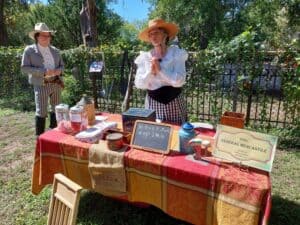
Bettie & Lester Peel – Peel General Mercantile
One September morning Bettie missed the train back to school for the fall semester. She slept late, just didn’t want to get up and go. And that’s the miracle. Why? Because that day was September 8, 1900, and the train was headed to Galveston. If she’d been on it and had disembarked to go to her school, there’s a good chance she’d have died, as did thousands of others that day—the day the Great Storm, a.k.a. the 1900 Galveston Hurricane, destroyed much of the island.
Did You Know…
- In 1838, a Methodist Congregation was established in Montgomery and in 1839, members built a log meetinghouse.
- In 1839, Montgomery’s first school was established.
- The town of Montgomery was the birthplace of the Lone Star Flag of the Republic of Texas. Montgomery resident Dr. Charles Bellinger Stewart’s flag design was officially adopted in 1839.
- The Mongomery Patriot, the first newspaper in the town and county, was established in 1845.
- The city of Montgomery was incorporated in 1848.
- In 1850, the Texas Conference of the Methodist Episcopal Church established a fulltime preacher in Montgomery. Prior to this (1838-1850), Methodist Episcopal Church circuit-riding preachers served the area.
- In 1850, Baptists, too, organized a fellowship in Montgomery, and in 1853 received their first full-time pastor.
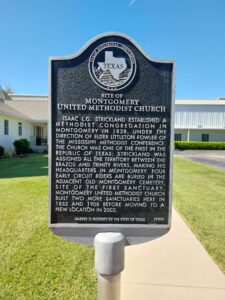
Montgomery United Methodist Historical Marker
Montgomery United Methodist Church
(HISTORICAL MARKER) “Site of Montgomery United Methodist Church: Isaac L.G. Strickland established a Methodist Congregation in Montgomery in 1838, under the direction of elder Littleton Fowler of the Mississippi Methodist Conference. The Church was one of the first in the Republic of Texas; Strickland was assigned all the territory between the Brazos and Trinity Rivers, making his headquarters in Montgomery. Four early circuit riders are buried in the adjacent Old Montgomery Cemetery, site of the first sanctuary. Montgomery United Methodist Church built two more sanctuaries here in 1852 and 1908 before moving to a new location in 2002.”
New Montgomery Cemetery (1868)
In 1868, four horse thieves plagued the area. When word reached the town, the hunt was on. Three thieves were shot and killed, the fourth, a sixteen-year-old boy, hid under a bed in a local boarding house. The mob promised they wouldn’t shoot him if he came out. They kept their word. They didn’t shoot him—they stabbed him to death.
One of the thieves, who came from a respected family in the area and who’d served in town on the right side of the law before trying his hand—unsuccessfully—on the wrong side of it, was the first burial in Montgomery’s New Cemetery. (His three buddies were dumped in an unmarked grave outside the cemetery.)
The Miracle of Montgomery
Montgomery’s biggest miracle happened in 1910 when sixteen-year-old John Bowe Addison went rabbit and bird hunting with friends. He carried his pistol stuck in the waist of his pants. Prior to crawling under a barbed-wire fence, he pulled it out and put it on the ground in front of him. On the other side, he picked up the pistol to put it back in his belt, but it snagged on something and went off, shooting him in the abdomen.
One of the boys ran to John’s house where his widowed mother fired her shotgun three times to bring the sheriff and help. They carried John home and put him on his mother’s table, where the doctor performed surgery. Bit by bit, the doctor removed the teen’s intestines, patching where needed, before placing each section on the family’s large meat platter. When he’d repaired all the damage, the doctor put the intestines back in the boy and sewed him up.
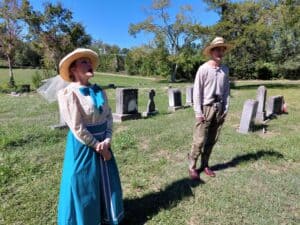
John B. Addison and his mother.
Normally, gut shots were fatal, but not that night. That night prayers were answered and John lived. His recovery was long and difficult, but he made it. In fact, several years later he joined the U.S. Army and fought and survived World War I. After the war, he returned to Montgomery where he lived until 1974, dying at the age of 80.
Oh, and according to his “mother,” the family only had one large meat platter, so afterward she washed it and continued to use it for meals . . . though she never mentioned to her guests that it had once held her son’s intestines.
The Old Methodist Churchyard
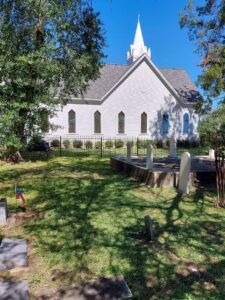
A portion of the Methodist Graveyard.
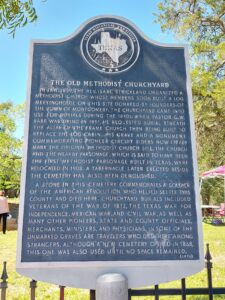
The Old Methodist Churchyard Historical Marker
(HISTORICAL MARKER) “The Old Methodist Churchard: In Jan. 1839, the Rev. Isaac Strickland organized a Methodist Church whose members soon built a log meetinghouse on this site donated by founders of the town of Montgomery. The churchyard came into use for burials during the 1840s. When Pastor G.W. Rabb was dying in 1851, he requested burial beneath the altar of the frame church then being built to replace the log cabin. His grave and a monument commemorating pioneer circuit riders now (1976) mark the original Methodist Church site. The church and the nearby parsonage, which is said to have been the first Methodist parsonage built in Texas, were relocated in 1908. A tabernacle later erected beside the cemetery has also been demolished.
A stone in this cemetery commemorates a soldier of the American Revolution who helped settle this county and died here. Churchyard burials included veterans of the War of 1812, the Texas War for Independence, Mexican War, and the Civil War, as well as many other pioneers, state and county officials, merchants, ministers, and physicians. In some of the unmarked graves are travelers who died here among strangers. Although a new cemetery opened in 1868, this one was also used until no space remained.”

